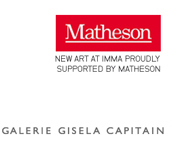Karla Black is regarded as one of the pioneering contemporary artists of her generation. A Turner Prize nominee in 2011, she practices a kind of lyrical autonomous sculpture, influenced by psychoanalysis, feminism and its impact on visual art. Black’s work draws from a multiplicity of artistic traditions from expressionist painting, land art, performance, to formalism. Black questions the rigours of sculptural form and her large-scale sculptures incorporate modest everyday substances, along with very traditional art-making materials to create abstract formations.
The site-specific exhibition at IMMA will present Karla Black’s extraordinary creative output, revealing the artist’s constant challenges to prevailing concepts of sculpture. Her interest in process has led her to expand the possibilities of whichever material she employs; from plaster, polythene, chalk dust and powder to eye-shadow, nail varnish, fake tan or toothpaste. Black chooses her media for their tactile aesthetic appeal: the familiarity of the texture of cellophane or the scent of cosmetics bridges the experience of tangible matter with the intimacy of memory of the subconscious. Black’s working process is intensely physical and this energy is conveyed through works that emphasise her free, experimental working method, combined with the editing, muting and reigning in of careful aesthetic judgement. Each element in her assemblages interconnects physical, psychological, and theoretical stimuli which are both self-referential and relate to art as a wider-world experience.
Experimenting with ways to float material, form and colour at eye level remains a constant preoccupation in Black’s work, and this preoccupation remains as a thread in the exhibition at IMMA, which will present Black’s extraordinary creative output through a series of new works tailored for the spaces at IMMA.
Karla Black has stated in relation to her forthcoming exhibition at IMMA
‘I am preoccupied with trying to find ways to float material, form and colour at eye level. Over the years, I have discovered makeshift sculptural solutions that allow this to happen, while actively avoiding the obvious traditional tropes – painting a canvas and putting it on a wall, placing an object on a plinth or shelf etc. This preoccupation remains as I develop experimentation for the IMMA show’.
Black has said previously of her work:
‘While there are ideas about psychological and emotional developmental processes held within the sculptures I make, the things themselves are actual physical explorations into thinking, feeling, communicating and relating’.
This exhibition is presented with the kind support of


